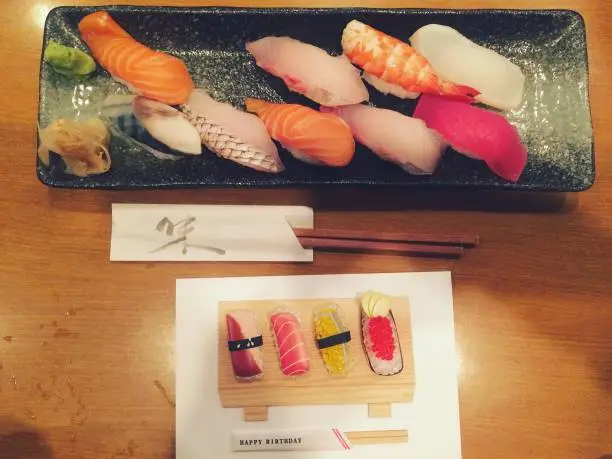Sushi has become a beloved global cuisine, celebrated for its fresh ingredients, balanced flavors, and beautiful presentation. However, if you’re new to sushi, deciphering a sushi menu can feel overwhelming. With terms like maki, nigiri, and sashimi, you may wonder where to begin and how to build the perfect sushi order.
Don’t worry—you’re not alone! Ordering sushi like a pro is simpler than it seems, and this guide will help you navigate the basics, types of sushi, and how to structure a satisfying meal. Let’s dive into the essentials of ordering sushi, so your next meal is a breeze.
1. Sushi Basics: Understanding Your Options
Before diving into the menu, it’s important to grasp the basics of sushi. Contrary to common belief, the term “sushi” refers to the vinegared rice, not the fish. So any dish that includes this rice, paired with fish, vegetables, or other toppings, is considered sushi.
Here’s a quick breakdown of common sushi types you’ll encounter:
Maki Rolls: The most familiar sushi style. Maki is seaweed-wrapped rice filled with fish, veggies, or other ingredients.
Nigiri: This is a small mound of sushi rice topped with a slice of raw or cooked fish. Nigiri often includes a touch of wasabi between the fish and rice.
Sashimi: Sashimi consists of thinly sliced raw fish, served without rice. It’s pure and simple, highlighting the fresh flavors of the fish.
Temaki (Hand Rolls): These are cone-shaped rolls wrapped in seaweed, filled with rice and other ingredients. They’re eaten with your hands.
Uramaki: A type of roll with rice on the outside of the seaweed, often coated with sesame seeds or fish roe for extra flavor.
Now that you know the key sushi types, let’s talk about how to order like a seasoned sushi lover.
2. Start with Light Flavors
When ordering sushi, it’s best to start with light, delicate flavors before moving on to richer, more complex options. This allows your palate to appreciate the subtleties of each dish without overwhelming your taste buds early on.
Begin your meal with sashimi or nigiri featuring white fish like snapper or flounder. These milder fish offer a subtle taste and silky texture, making them an ideal introduction. You could also start with a light appetizer, such as miso soup or a simple seaweed salad, to cleanse your palate.
3. Mix Rolls and Nigiri for Variety
While maki rolls are a go-to favorite, nigiri provides a more traditional sushi experience. Nigiri places the focus on the fish, allowing its flavor and texture to shine. To order sushi like a pro, balance your meal with a mix of specialty rolls and nigiri.
Select one or two signature rolls that appeal to you—perhaps a spicy tuna roll or salmon avocado roll—and then round out your order with a few pieces of nigiri. Classic nigiri choices include tuna (maguro), salmon (sake), and yellowtail (hamachi). The combination of rolls and nigiri ensures a variety of flavors and textures.
4. Try Sashimi for a Pure Experience
If you want to truly savor the freshness of the fish, don’t hesitate to order sashimi. While sashimi is served without rice, it allows you to experience the raw fish in its purest form. Many sushi enthusiasts appreciate sashimi for its clean, unadulterated taste.
If you’re new to sashimi, start with familiar fish like salmon or tuna, which have rich, buttery flavors. As you get more comfortable, explore more adventurous options like octopus (tako) or mackerel (saba).
5. Add a Hand Roll for Fun
For a change of pace, add a hand roll (temaki) to your order. Hand rolls are cone-shaped, with seaweed wrapped around rice, fish, and veggies. They’re typically eaten by hand and offer a casual, fun way to enjoy sushi.
Popular temaki fillings include spicy tuna, shrimp tempura, or salmon with avocado. The crispy seaweed paired with the fresh ingredients makes for a delicious, handheld treat that adds variety to your meal.
6. Look for Seasonal Specials
Sushi restaurants often feature seasonal fish that’s at its peak flavor during certain times of the year. To elevate your sushi experience, ask your server about any seasonal specials or the freshest fish available that day.
For example, fatty tuna (otoro) is best enjoyed in the winter, while uni (sea urchin) is at its freshest in the summer. Ordering seasonal fish not only enhances your meal but also shows an appreciation for the quality and freshness of the ingredients.
7. Enjoy Sushi the Right Way
Now that your sushi is on the table, here’s how to eat it like a pro:
Use chopsticks—or your hands, in the case of nigiri—to pick up the sushi.
If dipping nigiri into soy sauce, flip it so the fish side touches the soy sauce, not the rice. This keeps the rice from getting soggy.
Add a small dab of wasabi if you like a bit of spice, but don’t overdo it, as the goal is to enhance the fish’s flavor, not overpower it.
In between bites, cleanse your palate with a slice of pickled ginger (gari). This resets your taste buds, allowing you to fully enjoy the next bite.
Conclusion
Ordering sushi like a pro is all about understanding the variety of options and choosing dishes that highlight the quality and freshness of the ingredients. Whether you’re enjoying maki rolls, nigiri, or sashimi, creating a balanced order will ensure a delicious and satisfying meal.
Next time you visit a sushi restaurant, feel confident as you explore the menu and experiment with different types of sushi. With these tips in hand, you’ll be able to order sushi with knowledge and finesse, savoring each bite like a seasoned sushi connoisseur

 Uncategorized3 months ago
Uncategorized3 months ago
 Uncategorized7 months ago
Uncategorized7 months ago
 Uncategorized5 months ago
Uncategorized5 months ago
 Uncategorized4 months ago
Uncategorized4 months ago










